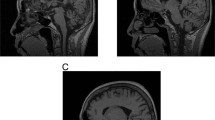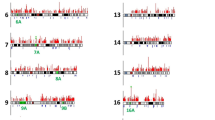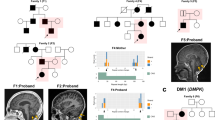Abstract
Spinocerebellar ataxia type 2 (SCA2) is an autosomal dominant, neurodegenerative disorder that affects the cerebellum and other areas of the central nervous system. We have devised a novel strategy, the direct identification of repeat expansion and cloning technique (DIRECT), which allows selective detection of expanded GAG repeats and cloning of the genes involved. By applying DIRECT, we identified an expanded CAG repeat of the gene for SCA2. CAG repeats of normal alleles range in size from 15 to 24 repeat units, while those of SCA2 chromosomes are expanded to 35 to 59 repeat units. The SCA2 cDNA is predicted to code for 1,313 amino acids — with the CAG repeats coding for a polyglutamine tract. DIRECT is a robust strategy for identification of pathologically expanded trinucleotide repeats and will dramatically accelerate the search for causative genes of neuropsychiatric diseases caused by trinucleotide repeat expansions.
This is a preview of subscription content, access via your institution
Access options
Subscribe to this journal
Receive 12 print issues and online access
$209.00 per year
only $17.42 per issue
Buy this article
- Purchase on Springer Link
- Instant access to full article PDF
Prices may be subject to local taxes which are calculated during checkout
Similar content being viewed by others
References
La Spada, A.R., Wilson, E.M., Lubahn, D.D., Harding, A.E. & fischbeck, K.H. Androgen receptor gene mutations in X-linked spinal and bulbar muscular atrophy. Nature 352, 77–79 (1991).
The Huntington's Disease Collaborative Research Group. A novel gene containing a trinucleotide repeat that is expanded and unstable on Huntington's disease chromosomes. Cell 72, 971–983 (1993).
Orr, H.T. et al. Expansion of an unstable trinucleotide CAG repeat in spinoeerebellar ataxia type 1. Nature Genet. 4, 221–226 (1993).
Koide, R. et al. Unstable expansion of CAG repeat in hereditary dentatorubral-pallidoluysian atrophy (DRPLA). Nature Genet. 6, 9–13 (1994).
Nagafuchi, S. et al. Dentatorubral and pallidoluysian atrophy expansion of an unstable CAG trinucleotide on chromosome 12p. Nature Genet. 6, 14–18 (1994).
Kawaguchi, Y et al. CAG expansion in a novel gene for Machado-Joseph disease at chromosome 14q32.1. Nature Genet. 8, 221–228 (1994).
Gispert, S. et al. Chromosomal assignment of the second locus for autosomal dominant cerebellar ataxia (SCA2) to chromosome 12q23–24.1. Nature Genet. 4, 295–299 (1993).
Pulst, S.M., Nechiporuk, A. & Starkman, S. Anticipation in spinoeerebellar ataxia type 2. Nature Genet. 5, 8–10 (1993).
Basset, A.S. & Honer, W.G. Evidence for anticipation in schizophrenia. Am. J. Hum. Genet 54, 864–870 (1994).
Mclnnis, M.G. et al. Anticipation in bipolar affective disorder. Am. J. Hum. Genet. 53, 385–390 (1993).
Ranum, L.P.W., Schut, L.J., Lundgren, J.K., Orr, H.T. & Livingston, D.M. Spinoeerebellar ataxia type 5 in a family descended from the grandparents of President Lincoln maps to chromosome 11. Nature Genet. 8, 280–284 (1994).
Gouw, L.G., Digre, K.B., Harris, C.P., Haines, J.H. & Ptacek, L.J. Autosomal dominant cerebellar ataxia with retinal degeneration. Neurology 44, 1441–1447 (1994).
Sanpei, K., Igarasni, S., Eguchi, I., Takiyama, Y., Tanaka, H., Tsuji, S. Direct detection of expanded (CAG/CTG) repeats in the myotonin-protein kinase genes of myotonic dystrophy patients using a high-stringency hybridization method. Biochem. Biophys. Res. Commun. 212, 341–346 (1995).
Saiki, R.K. et al. Primer-directed enzymatic amplification of DNA with a thermostable DNA polymerase. Science 239, 487–491 (1988).
Onodera, O. et al. Molecular cloning of a full-length cDNA for dentatorubral-pallidoluysian atrophy and regional expressions of the expanded alleles in the CNS. Am. J. Hum. Genet. 57, 1050–1060 (1995).
Trottier, Y. et al. Polyglutamine expansion as a pathological epitope in Huntington's disease and four dominant cerebellar ataxia. Nature 378, 403–406 (1995).
Ihara, T. et al. Genetic heterogeneity of dominantly inherited olivopontocerebellar atrophy (OPCA) in the Japanese: linkage study of two pedigrees and evidence for the disease locus on chromosome 12q (SCA2). Jpn. J. Hum. Genet. 39, 305–313 (1994).
Cox, D.R., Burmeister, M., Price, E.R., Kim, S. & Myers, R.M. Radiation hybrid mapping: a somatic cell genetic method for constructing high-resolution maps of mammalian chromosomes. Science 250, 245–250 (1990).
Chung, M.-Y. et al. Evidence for a mechanism predisposing to inteigenerational CAG repeat instability in spinoeerebellar ataxia type I. Nature Genet. 5, 254–258 (1993).
Pulst, S.M. et al. Moderate expansion of a normally biallelic trinucleotide repeat in spinoeerebellar ataxi type 2. Nature Genet. 14, 269–276 (1996).
Kozak, M. An analysis of 5′-noncoding sequences from 699 vertebrate messenger RNAs. Nucl. Acids Res. 15, 8125–8148 (1987).
Imbert, G. et al. Cloning of the gene for spinocerebellar ataxia 2 reveals a locus with high sensitivity to expanded CAG/glutamine repeats and high instability. Nature Genet. 14, 285–291 (1996).
Yuan, J.-Y. et al. The C elegans cell death gene ced-3 encodes a protein similar to mammalian interleukin-1β-converting enzyme. Cell 75, 641–652 (1993).
Nicholson, D.W. et al. Identification and inhibition of the ICE/CED-3 protease necessary for mammmalian apoptosis. Nature 376, 37–43 (1995).
Goldberg, Y.P. et al. Cleavage of huntingtin by apopain, a proapoptotic cysteine protease, is modulated by the polyglutamine tract. Nature Genet. 13, 442–449 (1996).
Barr, P.J. Mammalian subtilisins: the long-sought dibasic processing endonucleases. Cell 66, 1–3 (1991).
Ikeda, H. et al. Expanded polyglutamine in the Machado-Joseph disease protein induces cell death in vitro and in vivo. Nature Genet. 13, 196–202 (1996).
Schalling, M., Hudson, T.J., Buetow, K.H. & Housman, D.E. Direct detection of novel expanded trinucleotide repeats in the human genome. Nature Genet. 4, 135–139 (1993).
Takano, H. et al. Somatic mosaicism of expanded CAG repeats in brains of patients with dentatorubral-pallidoluysian atrophy: Cellular population-dependent dynamics of mftotic Instability. Am. J. Hum. Genet. 58, 1212–1222 (1996).
Wahl, G.M., Stem, M. & Stark, G.R. Efficient transfer of large DNA fragments from agarose gels to diazobenzyloxy-methyl-paper and rapid hybridization by using dextran sulfate. Proc. Watt Acad Sci. USA 76, 3683–3687 (1979).
Feinberg, A.P. & Vogelstein, B.A. A technique for radiolabelling DNA restriction endonuclease fragments to high specific activity. Anal. Biochem. 132, 6–13 (1983).
Tsuji, S. et al. Genetic heterogeneity in type 1 Gaucher disease: Multiple genotypes in Ashkenazic and non-Ashkenazic individuals. Proc. Nati. Acad. Sci. USA 85, 2349–2352 (1988).
Kang, S., Jaworski, A., Ohshima, K. & Wells, R.D. Expansion and deletion of CTG repeats from human disease gene are determined by the direction of replication in E. coli.. Nature Genet. 10, 213–218 (1995).
Frohman, M.A., Dush, M.K. & Martin, G.R. Rapid production of full-length cDNAs from rare transcripts: Amplification using a single gene-specific oligonucleotide primer. Proc. Nati. Acad. Sci. USA 85, 8998–9002 (1988).
Chinjwin, J.M., Przbyla, A.E., MacDonald, R.J. & Rutter, W.J. Isolation of biologically active ribonucleic acid from sources enriched in ribonuclease. Biochemistry 18, 5294–5299 (1979).
Sanger, F., Nicklen, S. & Coulson, A.R. DNA sequencing with chain-terminating inhibitors. Proc. Natl. Acad. Sci. USA 74, 5463–5467 (1977).
Chen, E.Y. & Seeburg, P.H. Supercoil sequencing: a fast and simple method for sequencing plasmid DNA. DNA 4, 165–170 (1985).
Author information
Authors and Affiliations
Rights and permissions
About this article
Cite this article
Sanpei, K., Takano, H., Igarashi, S. et al. Identification of the spinocerebellar ataxia type 2 gene using a direct identification of repeat expansion and cloning technique, DIRECT. Nat Genet 14, 277–284 (1996). https://doi.org/10.1038/ng1196-277
Received:
Accepted:
Issue Date:
DOI: https://doi.org/10.1038/ng1196-277
This article is cited by
-
TR-FRET-Based Immunoassay to Measure Ataxin-2 as a Target Engagement Marker in Spinocerebellar Ataxia Type 2
Molecular Neurobiology (2023)
-
Therapy development for spinal muscular atrophy: perspectives for muscular dystrophies and neurodegenerative disorders
Neurological Research and Practice (2022)
-
The length of uninterrupted CAG repeats in stem regions of repeat disease associated hairpins determines the amount of short CAG oligonucleotides that are toxic to cells through RNA interference
Cell Death & Disease (2022)
-
Autophagy in Spinocerebellar ataxia type 2, a dysregulated pathway, and a target for therapy
Cell Death & Disease (2021)
-
Phenotypic and molecular diversities of spinocerebellar ataxia type 2 in Japan
Journal of Neurology (2021)



